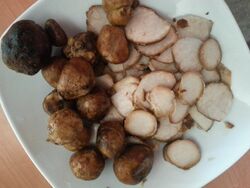Biology:Kalaharituber
| Kalaharituber | |
|---|---|

| |
| Scientific classification Error creating thumbnail: Unable to save thumbnail to destination
| |
| Domain: | Eukaryota |
| Kingdom: | Fungi |
| Division: | Ascomycota |
| Class: | Pezizomycetes |
| Order: | Pezizales |
| Family: | Pezizaceae |
| Genus: | Kalaharituber Trappe & Kagan-Zur (2005) |
| Species: | K. pfeilii
|
| Binomial name | |
| Kalaharituber pfeilii (Henn.) Trappe & Kagan-Zur (2005)
| |
| Synonyms | |
| |
Kalaharituber is a fungal genus in the family Pezizaceae.[1] It is a monotypic genus, whose single truffle-like species, Kalaharituber pfeilii, is found in the Kalahari Desert, which spans the larger part of Botswana, the east of Namibia and the Northern Cape Province of South Africa .[2][3][4]
Taxonomy
The fungus was first described scientifically in 1895 by German mycologist Paul Christoph Hennings as Terfezia pfeilii.[5] It was moved to its own genus in 2005 by James Trappe and Varda Kagan-Zur.[6]
Description
Fruiting bodies can be up to 12 cm in diameter. These weigh approximately 200 grams, although larger rains (which affect weight) can cause them to weigh twice as much.[2] These fruits grow close to the surface, which causes surface cracks on the ground above[3][7] after rains. These fruiting bodies can occur as much as 40 cm away from the main hyphae.[7]
Habitat
Kalaharituber pfeilii is found the Kalahari Desert, as well as in other arid regions of South Africa, Angola, Botswana and Namibia. It is found in soils with a pH ranging from 5.5 to 6.5, with a sand content varying from 94%-97%, a clay content varying from 2%-5% and a silt content varying from 1%-4%.[7]
Mycorrhizal relations with plants
Kalaharituber pfeilii is known to form an ectomycorrhizal relationship with Citrillus lanatus (watermelon), and is suspected to have a number of other possible relationships with other plant species. These include Sorghum bicolor, Eragrostis spp., Grewia flava,[3][4] several species of acacia,[7] and Cynodon dactylon.[3]
Edibility
Kalaharituber pfeilii is eaten by humans as well as by meerkats, hyenas, baboons and bat-eared foxes. According to a case study by the Australian National Botanic Gardens, the fruiting body is eaten by the Khoisan and other indigenous peoples of the Kalahari. Some commercial use of the species occurs.[2]
Conservation
The current populations of K. pfeilii are thought to be in deterioration, with possible causes advanced being over-harvesting, climate change or the land practices used in K. pfeilii habitats.[3][4]
References
- ↑ Lumbsch TH, Huhndorf SM. (December 2007). "Outline of Ascomycota – 2007". Myconet (Chicago, USA: The Field Museum, Department of Botany) 13: 1–58. Archived from the original on 2009-03-18. https://web.archive.org/web/20090318003134/http://www.fieldmuseum.org/myconet/outline.asp.
- ↑ 2.0 2.1 2.2 "Desert truffles - Australia and the Kalahari" (in en). Australian National Botanical Gardens. https://www.anbg.gov.au/fungi/case-studies/desert-truffles-aust.html.
- ↑ 3.0 3.1 3.2 3.3 3.4 "Home - Kalaharituber pfeilii F3 v1.0". http://genome.jgi.doe.gov/Kalpfe1/Kalpfe1.home.html.
- ↑ 4.0 4.1 4.2 Initiative, The Global Fungal Red List. "Kalaharituber pfeilii" (in en). http://iucn.ekoo.se/iucn/species_view/369302.
- ↑ Hennings, P. (1895). "Fungi camerunenses I". Botanische Jahrbücher für Systematik, Pflanzengeschichte und Pflanzengeographie 22: 72–111.
- ↑ Ferdman, Y.; Aviram, S.; Roth-Bejerano, N.; Trappe, J.M.; Kagan-Zur, V. (2005). "Phylogenetic studies of Terfezia pfeilii and Choiromyces echinulatus (Pezizales) support new genera for southern African truffles: Kalaharituber and Eremiomyces". Mycological Research 109 (2): 237–245. doi:10.1017/S0953756204001789. PMID 15839107.
- ↑ 7.0 7.1 7.2 7.3 "Desert Truffles". FUNGI Magazine. http://www.fungimag.com/Truffle-Issue-08-articles/desert-truffles.pdf.
Wikidata ☰ Q6350157 entry
 |

